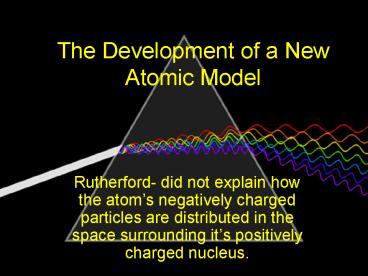The Development of a New Atomic Model - PowerPoint PPT Presentation
1 / 12
Title:
The Development of a New Atomic Model
Description:
... New understanding about the nature of energy, matter, ... Electromagnetic radiation has a dual wave-particle nature While like light act like a wave ... – PowerPoint PPT presentation
Number of Views:75
Avg rating:3.0/5.0
Title: The Development of a New Atomic Model
1
The Development of a New Atomic Model
- Rutherford- did not explain how the atoms
negatively charged particles are distributed in
the space surrounding its positively charged
nucleus.
2
(No Transcript)
3
The New Atomic Model
- Researcher used investigations into the
absorption and emission of light - Studies revealed a relationship beteen light an
atoms electrons - New understanding about the nature of energy,
matter, and atomic structure.
4
Properties of Light
- Before 1900, light was thought to behave solely
as a wave - Wavelike description
- It is type of electromagnetic radiation
- Forms part of the electromagnetic spectrum
- Significant wavelike motion characterized by
wavelength and frequency - Wavelength (?) is the distance between
corresponding points on adjacent waves. - Frequency (v) is the number of waves that pass a
specific point in a given time, usually one
minute.
5
Frequency and wavelength are mathematically
related to each other
- c?v c is the speed of light, a constant
- There for ?, wavelength in m, is inversely
proportional to v, frequency in s-1. - As wavelength decreases frequency increases and
vice versa
6
The Photoelectric Effect
- The photoelectric effect refers to the emission
of electron when light is shines on a metal.
7
The Photoelectric Effect
- The mystery was..
- No electron would be emmited if the lights
frequency (v) was below a certain minimum. - No matter how intense (W) the light was.
- Wave theory state that light of any frequency
could supply enough energy to eject an electron.
8
The Particle Description of Light
- Max Planck (1900 German Physicist)
- Studied emission of light by hot objects
- He proposed the hot objects do not emit
electromagnetic energy continuously (as would be
expected if all we were dealing with was a wave)
9
The Particle Description of Light
- Quantum- a measure of energy that is the minimum
quantity of energy that can be lost or gain by an
atom - Planck proposed a relationship between a quantum
of energy and the frequency of radiation - Ehv
- E energy in joules, v is frequency (s-1),
- h a fundamental physical constant now know as
Plancks constant 6.626x 10 -34
10
The Duality of particles and waves
- Albert Einstein expanded on Plancks work and
proposed a radical idea - Electromagnetic radiation has a dual
wave-particle nature - While like light act like a wave
- It is a stream of particles
- Each particle carries a quantum of energy
- These particles are called photons
- These particles have zero mass but carry a
quantum of energy
11
This explained the photoelectric effect
- Einstein explained
- Electromagnetic radiation is only absorbed by
matter in whole numbers - In order for an electron to be rejected from the
surface of the metal it must be struck by a
single photon possessing at least a minimum
energy required to knock the electron off. - Every metal has a different frequency
12
Home work
- Pages 124-125
- 1-25
- Complete sentences
- If it is a multiple choice problem, select the
letter choice them write a true complete sence
out of the question and the choice DO NOT COPY
THE QUESTIONS - If it is a calculation, show equation used and
ALL work - Have a great Thanksgiving!!!






























